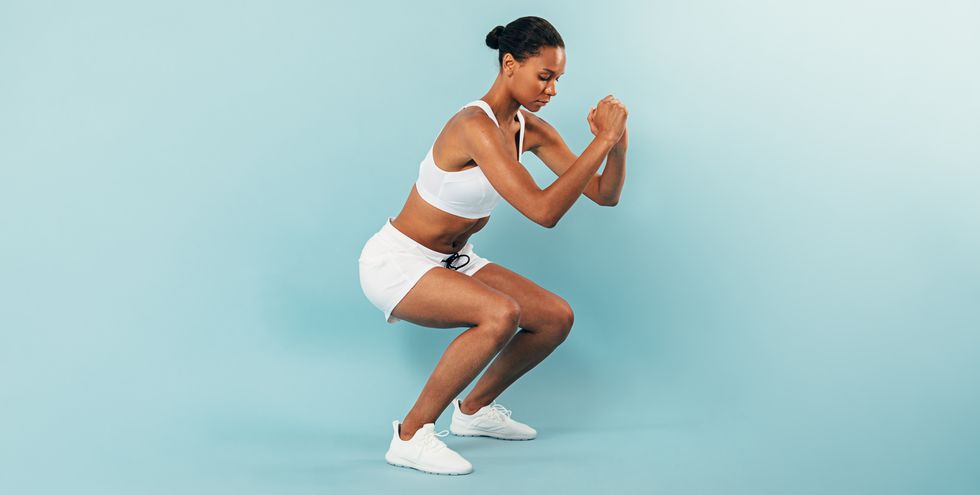The Best Butt Exercises for Toned Glutes, According to Celebrity Trainers
Whether you want your booty stronger, bigger, or more lifted, these workouts can help.

BY STEFANI SASSOS, MS, RDN, CSO, CDNSep 13, 2020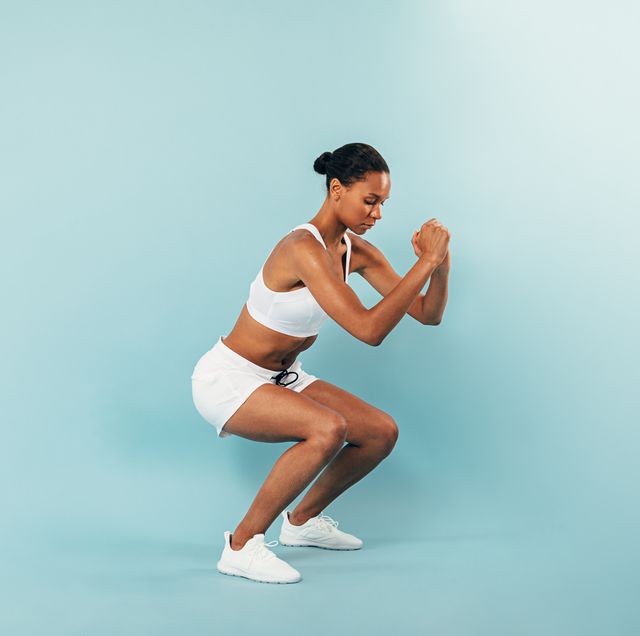 ARTEM VARNITSIN / EYEEMGETTY IMAGES
ARTEM VARNITSIN / EYEEMGETTY IMAGES
Bum, buttocks, gluteus maximus, booty … whatever you want to call it, glutes are more than just for aesthetics. Your glutes are made up of three different muscles: the gluteus maximus, gluteus medius, and gluteus minimus. Gluteus maximus seems to get all the attention, but medius and minimus also play very important roles. Together, these three muscles not only help to stabilize your pelvis but also assist with balance and knee extension.
Harley Pasternak, celebrity trainer, nutritionist, New York Times bestselling author, and Propel ambassador, says he wishes he knew the importance of glute strengthening earlier on in his life. “Whether it be lower back issues I’ve developed, knee issues, tearing my calves… if I had focused more on gluteus maximus and medius strength, most of these injuries wouldn’t have happened to that severity.” He says that making a concentrated effort on glute strength and training is very important not only from an injury prevention perspective, but also from a functional perspective.
Gunnar Peterson, celebrity trainer, strength and conditioning coach for the LA Lakers, and Propel ambassador, agrees and adds that consistent glute training has metabolic, aesthetic, functional, and performance benefits. “Metabolically, training your glutes is important and will pay you back after your workout,” Peterson shares. And when it comes to working out at home, Peterson says not to worry if you don’t have two of the same size weights. “Think about when you pick up two grocery bags that aren’t the same, or when you carry your suitcase and your friends suitcase that don’t weigh the same amount. Uneven loads are part of life and just create different core recruitment patterns. Grab what you have, be it a jug of water, a bottle of detergent, a backpack, and go with it.”
We sat down with both of these world-renowned celebrity trainers to find out the best glute exercises to incorporate into your workout at home or at the gym.Squat Sequence
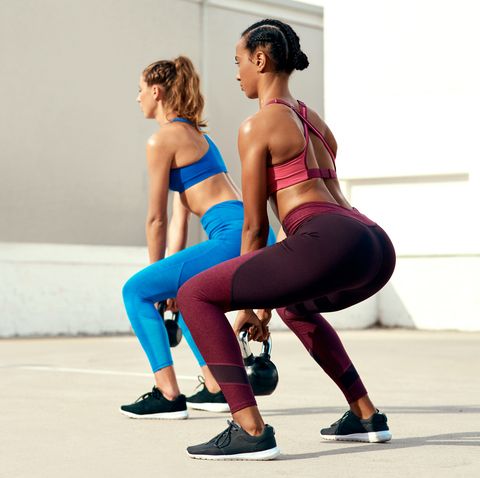
PEOPLEIMAGESGETTY IMAGES
Peterson swears by this squat sequence that plays with foot position to target different aspects of the glute muscles. He recommends doing 5 reps of each stance in a row and focusing on form before adding weight. A resistance band positioned just above your knees can also be useful. For all squat variations, inhale as you lower down and exhale as you come back up.
How to:
- Narrow Stance: Start standing tall with your feet together. Squat straight down, shooting your hips back and keeping your weight in your heels. Remember to keep your core engaged and chest upright throughout the movement. As you come back up, squeeze your glutes.
- Regular Stance: Start with your feet shoulder width apart and toes pointing forward. Squat straight down, shooting your hips back and keeping your weight in your heels. Aim for lowering your booty down so that it is parallel with your knees, ensuring that your knees stay over your ankles and do not track over your toes.
- Slight Turnout: Follow the form cues for a regular squat in this movement, but instead start with your feet a bit farther apart than regular squat stance and turn your toes out slightly.
- Full Sumo Stance: Start standing with your feet wider than your shoulders and toes pointed out at a 45 degree angle. Keep your chest up and core engaged as you bend your knees to lower down. Engage your glutes as you stand back up.
Advertisement – Continue Reading Belowhttps://d1dd8dca6a940e91ee63d1fb4f211e69.safeframe.googlesyndication.com/safeframe/1-0-37/html/container.htmlhttps://d1dd8dca6a940e91ee63d1fb4f211e69.safeframe.googlesyndication.com/safeframe/1-0-37/html/container.htmlGlute Bridge Sequence
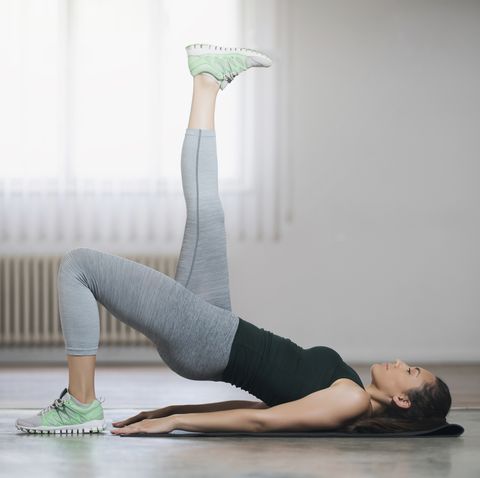
SRDJANPAVGETTY IMAGES
“What separates good programming from great programming is how you sequence these movements,” says Peterson. He recommends alternating movements from standing up to laying down when working the glutes, which can keep the heart rate up and tax the muscles.
After you finish your squat sequence, he recommends going straight into this glute bridge sequence. Perform 10 reps of each glute bridge variation in a row. Once you master the movement, Peterson suggests adding weight on your hip bones or bikini line area for women.
How to:
- Non-Dominant Side Single Leg Glute Bridge: Peterson likes working on the non-dominant side first to build it up since it’s often weaker (if you’re a righty, you’ll start with your left leg in the air, and vice versa). Lay on your back with knees bent, feet flat on the floor and about shoulder width apart, and arms next to your sides. Engage your core, pull the belly button in to your spine and recruit your glutes as you lift your hips up until they have created a “bridge,” which is a flat surface from chest to knees. From this position, lift your non-dominant leg straight up into the air. Squeeze the glutes for a second before lowering back down.
- Dominant Side Single Leg Glute Bridge: Repeat the same cues as step one but on the dominant leg.
- Narrow Double Leg Glute Bridge: Glue your legs and feet together for this glute bridge variation. Follow the same cues to engage your core and glutes as you lift your hips up, and come back down slow and controlled.
- Wide Double Leg Glute Bridge: Bring your feet wider than shoulder width apart for this glute bridge variation, and ensure you are pushing your knees outward and not letting them cave in.
Advertisement – Continue Reading Belowhttps://tpc.googlesyndication.com/safeframe/1-0-37/html/container.htmlClock Lunges
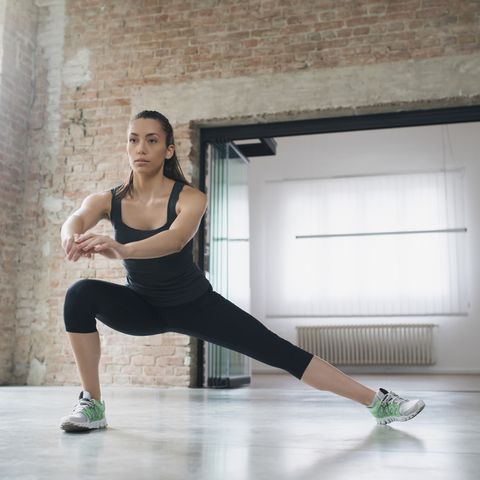
SRDJANPAVGETTY IMAGES
“From a functional standpoint, you’re driving off the glutes every time you stand up, reach down, or pivot. It’s a complex muscle group, so engaging your glutes at different angles deserves the extra attention when putting together your training program,” says Peterson. This lunge variation is perfect for targeting different angles of the booty after you complete your squat and glute bridge sequences.
How to:
Start standing tall with feet hip width apart, core engaged and chest lifted. Envision that you are standing in the center of a clock face. For each lunge variation, Peterson suggests locking in at that center spot to avoid flying through the movements. Perform 10 reps of each lunge variation in a row.
- 4 o’clock Lunge: Step your right foot to 4 o’clock, reach down and touch your toes, slightly bending the forward knee and pushing the hips back. Engage your core and glutes as you return to standing position.
- 3 o’clock Lunge: Step your right foot to 3 o’clock so you enter into a side lunge, reaching your left hand down to your right foot. Engage your core and glutes as you return to standing position.
- 8 o’clock Lunge: Step your left foot back to 8 o’clock, reach down and touch your toes, slightly bending the forward knee and pushing the hips back. Engage your core and glutes as you return to standing position.
- 9 o’clock Lunge: Step your left foot to 9 o’clock so you enter into a side lunge, reaching your right hand down to your left foot. Engage your core and glutes as you return to standing position.
Advertisement – Continue Reading Belowhttps://tpc.googlesyndication.com/safeframe/1-0-37/html/container.htmlhttps://d1dd8dca6a940e91ee63d1fb4f211e69.safeframe.googlesyndication.com/safeframe/1-0-37/html/container.htmlBent Knee Glute Kickback
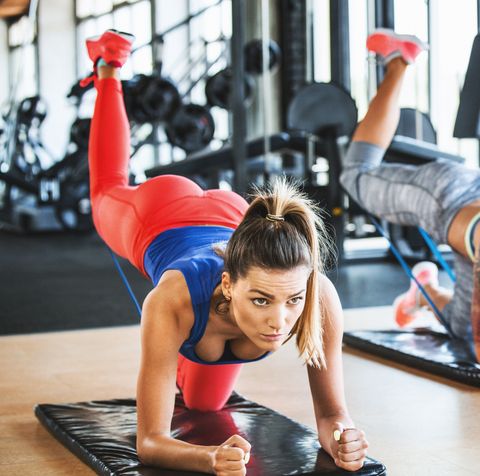
GILAXIAGETTY IMAGES
This classic toning move is perfect for sculpting your legs and booty. Peterson says he is a big fan of any kind of resistance over just body weight, so adding resistance bands placed on your thighs just above your knees in this move can make it more effective. Instead of flying through the movements, he recommends slowing down and moving with a purpose.
How to:
Start on a non-slip rug or padded mat with your forearms and knees on the floor. Core is engaged and lower abs are drawn in. Keep your left leg bent and foot flexed as you kick your left foot to the ceiling. Lower back down with control, and repeat 10 times on each leg.Single Leg Plyometric Jump

WESTEND61GETTY IMAGES
Plyometric exercises are often neglected, but Peterson says that as we age we lose a lot of movement patterns and practicing plyometrics is important to from a functional standpoint.
How to:
Start standing tall with core engaged. You can hold the side of a desk or credenza if you need extra support for this movement. Hinge your hips slightly and shoot the booty back, then explode up towards the ceiling with the right knee coming up towards the chest. Try to get 5 plyo jumps on each side, ensuring that your foot breaks contact with the ground and absorbs the landing.
Advertisement – Continue Reading BelowClamshells
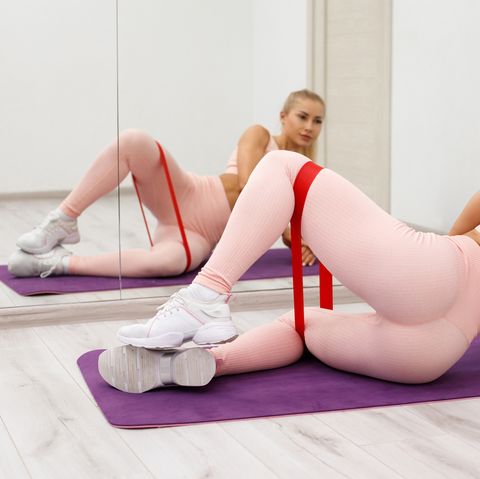
NIKOLAS_JKDGETTY IMAGES
Pasternak favors glute training because it ensures that the surrounding tissues aren’t overly restrictive and tight. He loves clamshells as a way to target the gluteus medius, and it’s one of our favorite glute exercises for women.
How to:
Lay down on your side, and make sure your head, hips, and heels are in one long plane. Place your fingertips on the floor in front of you to stabilize the body, and bend your knees in front of you. Keep your feet glued together as you float your top knee up to your hip, then lower back down. Perform 10-20 reps on one side, and repeat on the opposite side as well.Deadlift Sequence

SRDJANPAVGETTY IMAGES
If you’re looking for exercises to help build glutes with weights, the deadlift is a great go-to. Try these variations to target different angles of the glutes and lower body. Once you have built enough balance to move through the range of motion safely and without falling, you can add a dumbbell or kettlebell to the mix.
How to:
- Single Leg Deadlift: Start standing tall with your feet hip distance apart and core engaged. Push your hips back and shift your weight to one leg as the other leg begins to extend back behind you. There should be a slight bend in the knee and maximal bend in the hip for the working leg. Push your hips back until your chest is parallel with the ground. Then, squeeze your glutes and return to a standing position. Perform 10 reps on both sides.
- Kickstand Deadlift: Peterson swears by this deadlift variation. Start standing tall with core engaged and chest lifted. Position your feet in a split stance with the back foot off the floor and toes touching the ground. Push your hips back and hinge forward until your torso is nearly parallel with the floor. Drive through the whole foot and focus on pushing the floor away by extending the knees and hips. Return to the starting position and repeat for 10 reps. Then, switch sides.
- Straight Leg Deadlift: Start standing tall with your feet shoulder width apart. Hold a kettlebell, dumbbell, or barbell with an overhand grip, palms facing towards you. Keep your back straight and chest out as you push your hips back to lower the weight down just below your knees. Your knees can have a slight bend but the legs should mostly be straight. Then squeeze your glutes as you come back up. Perform 10-20 reps.
Advertisement – Continue Reading Belowhttps://tpc.googlesyndication.com/safeframe/1-0-37/html/container.htmlDolphin Extension

FOTOSTORMGETTY IMAGES
This efficient exercise is one of Pasternak’s signature moves. This is one of our favorite gym workouts for glutes and can be performed on a gym bench.
How to:
Start lying face down on a bench, ensuring that your upper body and hips are comfortably situated on the bench. Engage your core and hold the bench with your upper body as you lift up your lower body, performing the bottom half of a superman as you lie down on the bench. Lower down with control, and repeat 10-20 times.Walking Lunges
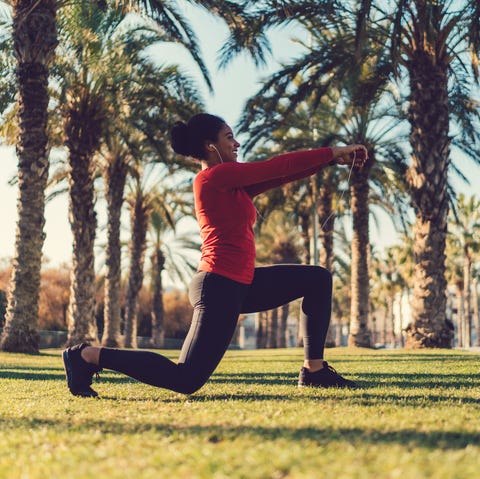
MARTIN-DMGETTY IMAGES
Looking for simple glute exercises to do at home? Pasternak loves walking lunges because they work so much of the lower body. He’s not a fan of adding dumbbells in a walking lunge and instead favors doing more reps. Pasternak add he and his family do walking lunges around the block of their home.
How to:
Start standing tall with feet hip width apart. Take a controlled step forward with your right leg as you lower your hips to the floor and blend both knees in 90 degree angles. The back knee should be just hovering over the ground, and your front. knee should be directly over your ankle. Engage your glutes as you stand back up with control, and then repeat alternating legs.Advertisement – Continue Reading Belowhttps://d1dd8dca6a940e91ee63d1fb4f211e69.safeframe.googlesyndication.com/safeframe/1-0-37/html/container.htmlHip Thrust Off Bench
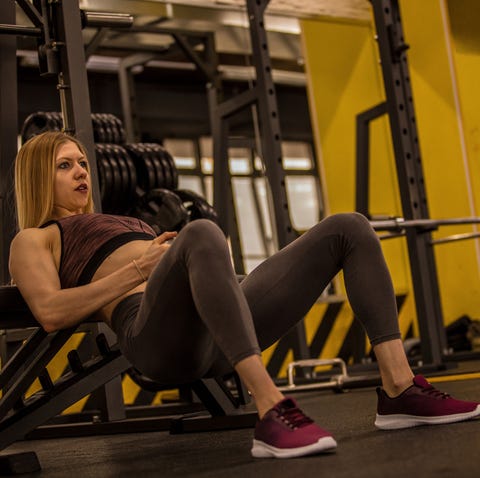
FOTOSTORMGETTY IMAGES
Pasternak is a fan of this movement that targets the glute muscles. The difference between this and a glute bridge is that the back is elevated off the ground, so there is an increased range of motion for your hips to travel during each repetition.
How to:
Sit on the ground with a bench behind you, and lean back so your shoulder blades are supported by the bench. Bend your knees at a 90 degree angle and plant your feet on the ground. Engage your core and glutes as you drive your hips up. Pause at the top of the movement and squeeze your glutes, then slowly lower back down. Once you master the movement, try adding a resistance band just above your knees on your thighs, or placing a weight at your hip crease.Weighted Step Up
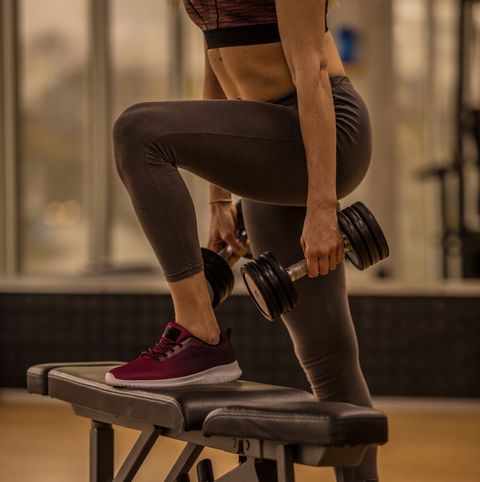
FOTOSTORMGETTY IMAGES
This simple movement can be done at home, at the park, or at the gym. Grab a sturdy chair, bench, or stool and a weight for this effective lower body exercise to lift the buttocks.
How to:
Stand up straight with core engaged and holding a weight in each hand. Alternatively, you can grab one weight and hold it by your chest with both hands. Step up on the bench or platform with your right foot, pressing through the right heel and engaging the booty as you straighten your right leg. Avoid letting your left leg propel you up and focus on the right leg doing the work. Bring the left foot up to meet the right foot on the top of the platform. Bend the right knee and step down with the left foot, then bring both feet down to the starting position. Repeat 10 times, then switch to the left side initiating the movement.Advertisement – Continue Reading Belowhttps://tpc.googlesyndication.com/safeframe/1-0-37/html/container.htmlSeated Abduction Machine
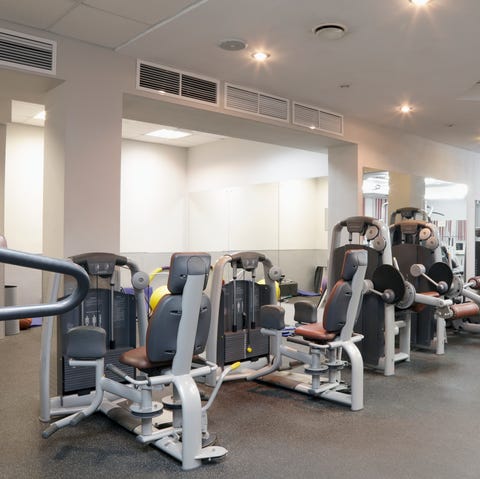
MINT IMAGESGETTY IMAGES
Pasternak loves this piece of gym equipment so much that he even bought one for his home. This gym glute workout move targets the glutes medius and maximus. If you can’t make it to the gym, sit in a chair and use a slingshot band around your thighs to mimic the movement at home.
How to:
Start seated in the machine with your legs inside of the pads. Pull the lever on the side of the machine to allow your legs to come together. Release the side lever to lock your legs into position. Sit back and grab the handles at your sides, then exhale as you push against the pads with your knees. At the top of the extension, pause for a moment, and then inhale as you reverse the movement and return to the starting position. Repeat 10-20 times.
